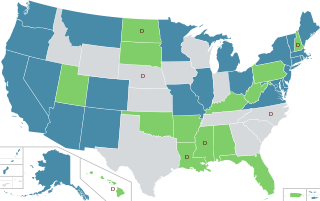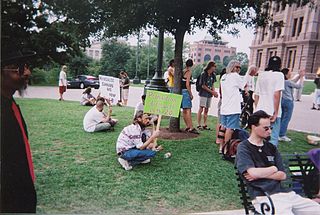Related Research Articles

The Marijuana Policy Project (MPP) is the largest organization working solely on marijuana policy reform in the United States in terms of its budget, number of members, and staff.
Although in its early years of statehood, Alaska was a Democratic state, since the early 1970s it has been characterized as Republican-leaning. Local political communities have often worked on issues related to land use development, fishing, tourism, and individual rights. Alaska Natives, while organized in and around their communities, have been active within the Native corporations. These have been given ownership over large tracts of land, which require stewardship. The state has an independence movement favoring a vote on secession from the United States, with the Alaskan Independence Party, but its membership has shrunk in recent decades.
Ravin v. State, 537 P.2d 494, was a unanimous decision by the Alaska Supreme Court. Decided on May 27, 1975, the Court held that the Alaska Constitution's right to privacy protects an adult's ability to use and possess a small amount of marijuana in the home for personal use. The Alaska Supreme Court thereby became the first—and only—state or federal court to announce a constitutional privacy right that protects some level of marijuana use and possession.

Cannabis in Colorado has been legal for medical use since 2000 and for recreational use since late 2012. On November 7, 2000, 54% of Colorado voters approved Amendment 20, which amended the State Constitution to allow the use of marijuana in the state for approved patients with written medical consent. Under this law, patients may possess up to 2 ounces (57 g) of medical marijuana and may cultivate no more than six marijuana plants. Patients who were caught with more than this in their possession could argue "affirmative defense of medical necessity" but were not protected under state law with the rights of those who stayed within the guidelines set forth by the state. The Colorado Amendment 64, which was passed by voters on November 6, 2012, led to recreational legalization in December 2012 and state-licensed retail sales in January 2014. The policy has led to cannabis tourism. There are two sets of policies in Colorado relating to cannabis use: those for medicinal cannabis and for recreational drug use along with a third set of rules governing hemp.
In the late 2000s and early 2010s, advocacy for drug legalization has increased in Latin America. Spearheading the movement Uruguayan government announced in 2012 plans to legalize state-controlled sales of marijuana in order to fight drug-related crimes.

The legal history of cannabis in the United States began with state-level prohibition in the early 20th century, with the first major federal limitations occurring in 1937. Starting with Oregon in 1973, individual states began to liberalize cannabis laws through decriminalization. In 1996, California became the first state to legalize medical cannabis, sparking a trend that spread to a majority of states by 2016. In 2012, Washington and Colorado became the first states to legalize cannabis for recreational use.
Alaska Measure 2 was a successful 2014 ballot measure in the U.S. state of Alaska, described as "An Act to tax and regulate the production, sale, and use of marijuana". The measure went into effect on 24 February 2015, allowing Alaskans age 21 and older to possess up to an ounce of cannabis and six plants, making Alaska the third state to legalize recreational marijuana, following Colorado and Washington. Oregon and Alaska both voted in legalization on Election Day 2014, but Alaska preceded Oregon in enacting their legislation.
Alaska Measure 2 or the Alaska Marijuana Criminalization Initiative was a successful 1990 ballot measure in the U.S. state of Alaska; the initiative stated that it: "would change Alaska's laws by making all such possession of marijuana criminal, with possible penalties of up to 90 days in jail and/or up to a $1000 fine."

Cannabis in Guam has been legal for medical use since 2015 and legal for recreational use since April 2019. Guam was the first United States Territory to legalize medical marijuana, passing via a ballot referendum in 2014.

Cannabis in Arkansas is illegal for recreational use. First-time possession of up to four ounces (110 g) is punished with a fine of up to $2,500, imprisonment of up to a year, and a mandatory six month driver's license suspension. Medical use was legalized in 2016 by way of a ballot measure to amend the state constitution.

Cannabis in North Dakota is legal for medical use but illegal for recreational use. Since 2019 however, possession under a 1/2 ounce has been decriminalized in the sense that there is no threat of jail time, though a criminal infraction fine up to $1,000 still applies. The cultivation of hemp is currently legal in North Dakota. In November 2018, the state's voters voted on recreational marijuana legalization, along with Michigan; the measure was rejected 59% to 41%. Two groups attempted to put marijuana legalization measures on the June 2020 Primary and the November 2020 elections, but were prevented from doing so by the COVID-19 pandemic.

Cannabis in Oklahoma is illegal for recreational use, but legal for medical use with a state-issued license, while CBD oil derived from industrial hemp is legal without a license.

Cannabis in Alaska is legal for recreational use since 2015. It was first legalized by the court ruling Ravin v. State in 1975, but later recriminalized by Measure 2 in 1990. Ballot measures in 2000 and 2004 attempted to legalize recreational use, until finally Measure 2 in 2014 passed with 53.2% of the vote. Medical use was legalized by way of Measure 8 in 1998.

The Adult Use of Marijuana Act (AUMA) was a 2016 voter initiative to legalize cannabis in California. The full name is the Control, Regulate and Tax Adult Use of Marijuana Act. The initiative passed with 57% voter approval and became law on November 9, 2016, leading to recreational cannabis sales in California by January 2018.

Cannabis in Texas is illegal for recreational use. Possession of up to two ounces is a class B misdemeanor, punishable by up to 180 days in prison and a fine of up to $2000. Several of the state's major municipalities have enacted reforms to apply lesser penalties or limit enforcement, however.

Cannabis in Arizona is legal for recreational use. A 2020 initiative to legalize recreational use passed with 60% of the vote. Possession and cultivation of recreational cannabis became legal on November 30, 2020, with the first state-licensed sales occurring on January 22, 2021.

Cannabis in New York has been legal for medical purposes under New York law since 2016, and recreational purposes since 2021. As of 2022, recreational cannabis is for sale legally in the state.

Cannabis in New Jersey is legal for both medical use and recreational use. An amendment to the state constitution legalizing cannabis became effective on January 1, 2021, and enabling legislation and related bills were signed into law by governor Phil Murphy on February 22, 2021.

Cannabis in Maryland is legal for medical use and recreational use. Possession of up to 1.5 ounces and cultivation of up to 2 plants is legal for adults 21 years of age and older. In 2013, a state law was enacted to establish a state-regulated medical cannabis program. The program, known as the Natalie M. LaPrade Maryland Medical Cannabis Commission (MMCC) became operational on December 1, 2017.

Question 4 was a voter referendum to amend the Constitution of Maryland in order to legalize cannabis for adult use in Maryland. The referendum was approved overwhelmingly, with more than twice as many voters voting in favor of it than against it, on November 8, 2022, and will go into effect on July 1, 2023.
References
- ↑ "Alaska Court Upholds Privacy Right to Smoke Marijuana in the Home". www.cognitiveliberty.org. Archived from the original on 2003-09-07.
- ↑ http://scholarship.law.duke.edu/cgi/viewcontent.cgi?article=1343&context=alr [ bare URL PDF ]
- ↑ "NOY v. STATE". Findlaw.
- ↑ Niraj Chokshi (2021-12-06) [2015-02-24]. "Alaska legalizes marijuana today. Here's how its law compares to all the others". The Washington Post . Washington, D.C. ISSN 0190-8286. OCLC 1330888409.[ please check these dates ]